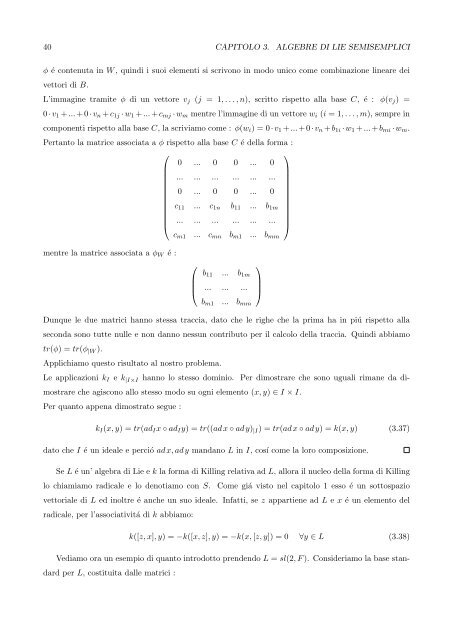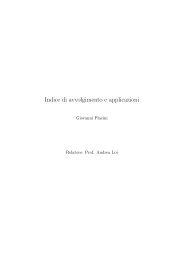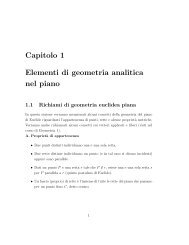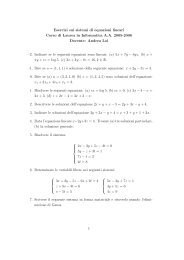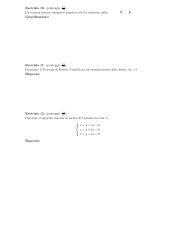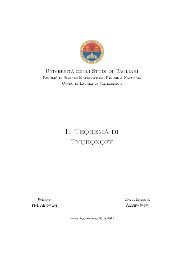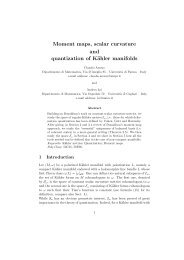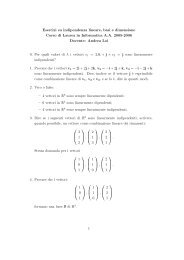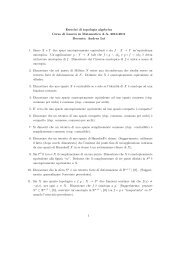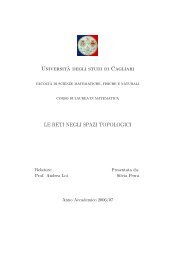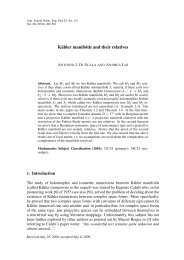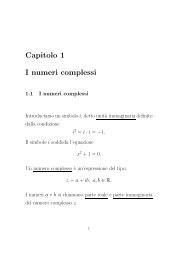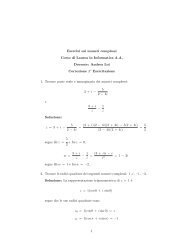Algebre di Lie semisemplici, sistemi di radici e loro classificazione
Algebre di Lie semisemplici, sistemi di radici e loro classificazione
Algebre di Lie semisemplici, sistemi di radici e loro classificazione
You also want an ePaper? Increase the reach of your titles
YUMPU automatically turns print PDFs into web optimized ePapers that Google loves.
40 CAPITOLO 3. ALGEBRE DI LIE SEMISEMPLICI<br />
φ é contenuta in W , quin<strong>di</strong> i suoi elementi si scrivono in modo unico come combinazione lineare dei<br />
vettori <strong>di</strong> B.<br />
L’immagine tramite φ <strong>di</strong> un vettore vj (j = 1, . . . , n), scritto rispetto alla base C, é : φ(vj) =<br />
0 · v1 + ... + 0 · vn + c1j · w1 + ... + cmj · wm mentre l’immagine <strong>di</strong> un vettore wi (i = 1, . . . , m), sempre in<br />
componenti rispetto alla base C, la scriviamo come : φ(wi) = 0 · v1 + ... + 0 · vn + b1i · w1 + ... + bmi · wm.<br />
Pertanto la matrice associata a φ rispetto alla base C é della forma :<br />
⎛<br />
⎞<br />
⎜<br />
⎝<br />
0<br />
...<br />
0<br />
c11<br />
...<br />
...<br />
...<br />
...<br />
...<br />
...<br />
0<br />
...<br />
0<br />
c1n<br />
...<br />
0<br />
...<br />
0<br />
b11<br />
...<br />
...<br />
...<br />
...<br />
...<br />
...<br />
0<br />
...<br />
0<br />
b1m<br />
...<br />
⎟<br />
⎠<br />
mentre la matrice associata a φW é :<br />
cm1 ... cmn bm1 ... bmm<br />
⎛<br />
⎜<br />
⎝<br />
b11 ... b1m<br />
... ... ...<br />
bm1 ... bmm<br />
Dunque le due matrici hanno stessa traccia, dato che le righe che la prima ha in piú rispetto alla<br />
seconda sono tutte nulle e non danno nessun contributo per il calcolo della traccia. Quin<strong>di</strong> abbiamo<br />
tr(φ) = tr(φ |W ).<br />
Applichiamo questo risultato al nostro problema.<br />
Le applicazioni kI e k |I×I hanno lo stesso dominio. Per <strong>di</strong>mostrare che sono uguali rimane da <strong>di</strong>-<br />
mostrare che agiscono allo stesso modo su ogni elemento (x, y) ∈ I × I.<br />
Per quanto appena <strong>di</strong>mostrato segue :<br />
kI(x, y) = tr(adIx ◦ adIy) = tr((ad x ◦ ad y) |I) = tr(ad x ◦ ad y) = k(x, y) (3.37)<br />
dato che I é un ideale e perció ad x, ad y mandano L in I, cosí come la <strong>loro</strong> composizione.<br />
Se L é un’ algebra <strong>di</strong> <strong>Lie</strong> e k la forma <strong>di</strong> Killing relativa ad L, allora il nucleo della forma <strong>di</strong> Killing<br />
lo chiamiamo ra<strong>di</strong>cale e lo denotiamo con S. Come giá visto nel capitolo 1 esso é un sottospazio<br />
vettoriale <strong>di</strong> L ed inoltre é anche un suo ideale. Infatti, se z appartiene ad L e x é un elemento del<br />
ra<strong>di</strong>cale, per l’associativitá <strong>di</strong> k abbiamo:<br />
⎞<br />
⎟<br />
⎠<br />
k([z, x], y) = −k([x, z], y) = −k(x, [z, y]) = 0 ∀y ∈ L (3.38)<br />
Ve<strong>di</strong>amo ora un esempio <strong>di</strong> quanto introdotto prendendo L = sl(2, F ). Consideriamo la base stan-<br />
dard per L, costituita dalle matrici :


